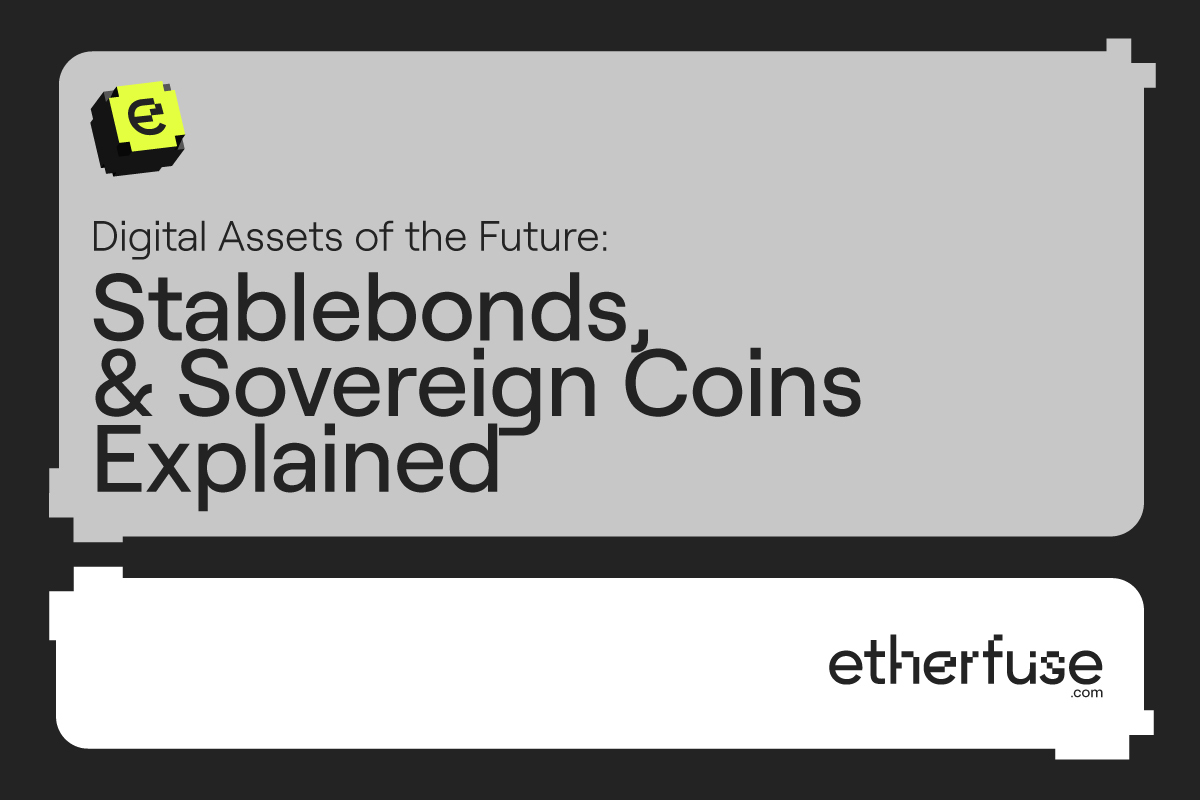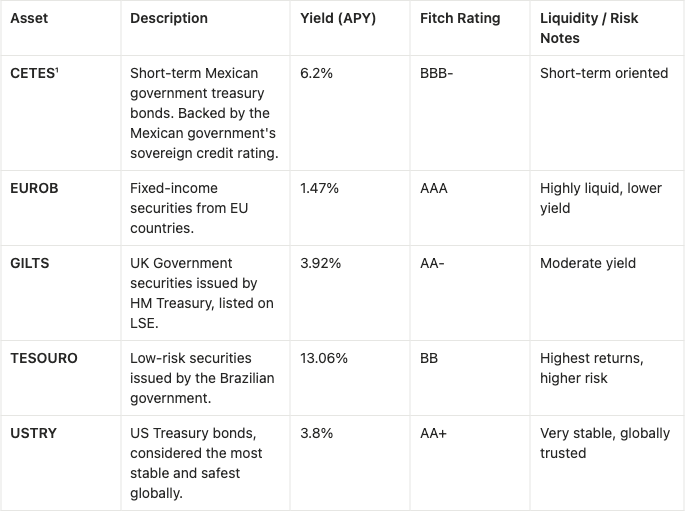Etherfuse
Digital Assets of the Future: Stablecoins, Stablebonds, and Sovereign Coins Explained

Not all “stable” digital assets are created equal. While stablecoins like USDC and USDT have become household names in crypto, a new wave of instruments are pushing the boundaries of what digital money can do. These assets don’t just hold value; they can generate yield, provide everyday utility, and connect investors directly to government debt markets. In this piece, we’ll break down what each is, how they differ from Stablebonds, and why they matter for the future of finance.
STABLECOINS
Stablecoins are essentially a digital version of a currency, like the US Dollar.
For every stablecoin issued, the company behind it keeps a corresponding amount of that asset in reserve, so the coin can always be exchanged for it. This backing keeps the price steady. For example, 1 USDC or USDT is always close to 1 U.S. dollar.
All transactions are recorded on a blockchain, making them transparent, secure, and easy to transfer between wallets.
Common use cases:
- Payments and Remittances – Stablecoins let people send money across borders instantly and cheaply, whether paying for goods online or sending funds to family abroad. They work like digital dollars that move with just a phone.
- Storing and Protecting Value – In countries with high inflation, stablecoins give people a safe way to hold savings in dollars without a bank account. Crypto traders also use them as a stable place to park funds between trades.
- Access to DeFi ****– Stablecoins power lending, borrowing, and earning interest in decentralized finance (DeFi). They provide access to financial tools that are often unavailable in weak or limited banking systems.
Typical APY:
Because they are so low risk, typical APY (Annual Percentage Yield) rates for holding stablecoins directly are close to zero. However, investors can earn modest yields by lending them out through centralized exchanges, decentralized protocols, or yield-bearing wallets.
How to buy
Through centralized exchanges (e.g., Coinbase, Binance, Kraken), decentralized exchanges (e.g., Uniswap, Curve,PancakeSwap, Balancer), or directly through wallets that integrate fiat onramps (e.g., MetaMask, Phantom, or Trust Wallet).
STABLEBONDS
Stablebonds, on the other hand, are an innovative product offered by Etherfuse. As their name suggests, they relate to bonds (specifically government bonds). These are essentially loans given to a government in exchange for repayment plus interest at a later date.
What makes stablebonds so compelling is that they combine three key elements: the stability of government-backed debt, with yield that is far greater than stablecoins, all the while benefiting from the accessibility and cost-cutting provided by blockchain technology.
Features:
- Security: Since they are government-backed, the credit risk (i.e. likelihood that you won’t be repaid) is low.
- Stability: Unlike crypto assets, which can sometimes experience wild price swings, stablebonds maintain a stable price.
- Blockchain advantages: Buying a digitized bond through blockchain offers several benefits compared to using traditional brokers. Costs are lower because middlemen are removed, and the barrier to entry is minimal. There’s no minimum investment, so you can start with as little as one U.S. dollar. All you need is a phone.
Typical APY:
As you can see in the table at the end of this blog, Etherfuse offers very competitive yields on stablebonds, from ~1.5% (EU bonds) to over 13% (Brazilian Tesouro) at the time of writing.
How to buy
Investors can purchase Stablebonds directly through the Etherfuse portal.
SOVEREIGN COINS
Sovereign Coins, another Etherfuse innovation, take the concept of stable digital money one step further. Think of them like Stablecoins but with a different security model.
Like stablecoins, they maintain price stability and are pegged 1:1 with the fiat currency they represent. They are commonly used for transactions, payroll, remittance payments and so on.
Unlike Stablecoins, however, they are backed by bond reserves. This is key, as it ties security to the government issuing the bond and is therefore very secure. Default risk exists but is considered low unless there’s a major economic or political crisis. ****For context, Mexico’s last major sovereign debt default was in 1982.
Unlike stablecoins, Sovereign Coins are backed by government bond reserves rather than cash or cash equivalents. This backing structure ties their security to the creditworthiness of the issuing government. While government bonds are not risk-free, they are generally considered lower-risk investments.
Currently, we offer MXNe, a Sovereign Coin pegged 1:1 to the Mexican Peso and collateralized by reserves in Mexican government bonds (CETES).
Features & Use Cases:
- Stable Value, Local Currency: Pegged 1:1 to a national currency, making them familiar and reliable for everyday use like payments, remittances, and payroll.
- Bond-Backed Reserves: Unlike stablecoins backed by cash or cash equivalents, Sovereign Coins are collateralized with government bonds, giving them both security and the potential to generate yield.
- Accessible & Inclusive: Can be bought and used directly with a smartphone, lowering barriers to financial tools like savings and sovereign debt that are usually out of reach.
How to buy
Sovereign Coins may be purchased directly through Etherfuse portal.
Annex: Etherfuse Stablebond Offerings & Ratings
Note: these yield figures are projections only, based on figures available in August 2025. The most up to date rates are available on our dashboard.

¹ CETES are not individually rated by S&P, Moody’s, or Fitch. The ratings shown reflect each agency’s assessment of Mexico’s sovereign credit, which underpins the risk profile of CETES.





